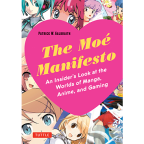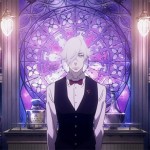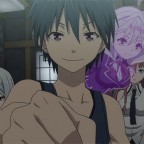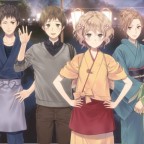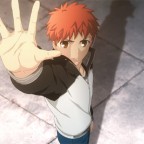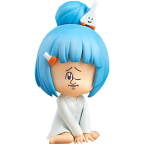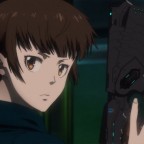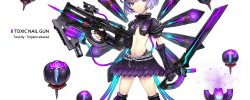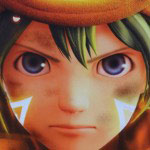The Melody of Oblivion DVD Review
It’s fairly easy to create an action oriented series. Take an angst teenager, give him some strange powers and have him fight random monsters. Hey, maybe we can add an attractive girl who will fall in love with him for no reason and a cool-looking rival! Yes, we’ve seen these kinds of shows appear again and again. It takes some courage to stray from the conventions and change the formula a little bit. The Melody of Oblivion takes all the conventions, rolls them up into a ball and throws them out the window. It dares you to challenge every convention and stigma you had about anime, and for the most part it succeeds brilliantly.
During the 20th century a war between the humans and the monsters took place. It was a ruthless and devastating war with many casualties. In its end the humans lost, and have become unable to resist the monsters’ will. Now humans must sacrifice 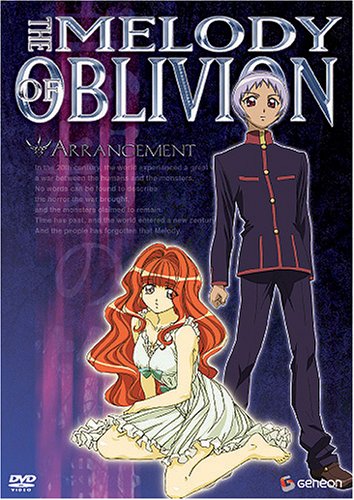 their children and loved ones to the monsters to keep the peace at bay. But there are those who still fight the monsters from the shadows. These are Melos Warriors – men and women who took upon themselves the legacy to fight the monsters even after humanity has all but forgotten about its life before the war. In this world we find Bocca – a disgruntled high school student who hates the corrupt humans and the monsters who govern them. When such a monster arrives in town Bocca discovers within him the power to become a Melos warrior. Together with a vagabond girl called Sayoko and an Aibar Machine (a state-of-the-art war motorcycle) called Elanvital, he goes on a journey to become a worthy Melos Warrior and eliminate all the monsters.
their children and loved ones to the monsters to keep the peace at bay. But there are those who still fight the monsters from the shadows. These are Melos Warriors – men and women who took upon themselves the legacy to fight the monsters even after humanity has all but forgotten about its life before the war. In this world we find Bocca – a disgruntled high school student who hates the corrupt humans and the monsters who govern them. When such a monster arrives in town Bocca discovers within him the power to become a Melos warrior. Together with a vagabond girl called Sayoko and an Aibar Machine (a state-of-the-art war motorcycle) called Elanvital, he goes on a journey to become a worthy Melos Warrior and eliminate all the monsters.
Bocca aspires to become a strong Melos warrior, but has in fact lived a sheltered life before becoming one. As the story unfolds he discovers more and more about the world around him. He learns about the monster union (a union created by power-hungry people to serve the monsters) and about the critical little things that made the war tip in the monsters favor. He also encounters other Melos Warriors: the devoted and strong warrior Kurofune, the insecure and shy Tone, and the seductive and lively Coco. Each Melos warrior has his or her own way of fighting and they all have Aiber machines who serve as their partners. Although some of the Melos Warriors meet up fairly early in the series they each have their own agenda and usually end up working alone. The story is strictly shown from Bocca’s point of view but the series does a good job at mixing up all the warriors together, without having them band in an unnatural way. The warriors fight with arrows that they charge with their “melody” before shooting, and at times ride their Aibar Machines into battle. The charging and shooting of the arrows, and well as riding the Aibar Machines are all presented in a sexualized way. Sexuality plays an important role in the personalities of all the Melos Warriors, and is usually presented in a symbolic way.
The monster union agents – the main adversaries of the Melos Warriors – are unique entities and can be very intelligent. They won’t show up to fight unless they have a clear advantage up their sleeve. The first couple of monster union agents you’ll encounter are fairly attached to a certain animal trait. By far the best of them is the ape union leader, who uses a giant monkey robot and adds the word saru (Japanese for ape) to almost every sentence in a witty and funny way. The monsters in the series are all famous creatures from Greek mythology, but with a twist – they look like normal humans. The monsters never try to disguise themselves as humans, but their looks can and will seem awfully out of place, giving them the air of a foreign presence befitting their unusual nature. They each have a special place they like to dwell in, and have unique “tastes” when it comes to humans. Since they are the most dangerous and powerful beings in the world they usually belittle the Melos Warriors and leave the fighting to the union agents.
The Melody of Oblivion uses a rich mix of cultural references, mainly from Greek mythology and Japanese folklore. For example, the monster Horo is the embodiment of the mythical minotaur and was sealed within the labyrinth, just as Greek mythology would have it. The labyrinth is a place where time doesn’t flow, and to get there Bocca and Sayoko board a ship called Urataro – a clear reference to Urashima Tarou from Japanese folklore. This is later confirmed again when Bocca makes a remake on how the labyrinth resembles the eternal palace where time stops (again, a place from Urashima Tarou’s story). Understanding the many references isn’t necessary to enjoy the plot, but spoting out the references in every episode can be very rewarding.
Another aspect of the series which is regularly used as shounen fodder but receives a twist here is the structure of the plot. The Melody of Oblivion is built as a series of “stages”, with each stage spanning a couple of episodes. Each stage usually has a different setting in terms of the location it takes place in, the Melos Warriors present and the monster union agents there. This gives a distinct feel to each and every stage, similar to what people experience when they play old NES megaman games.
It should be noted that despite its structure and main objective the Melody of Oblivion is not an action oriented series. There are few battles during the series, and no blood or corpses are ever shown. Most of the episodes are dedicated to understanding the stage itself and ask questions like: Where are we? Is there a monster here? Do the people here resent the monsters or not? There are lengthy investigations and lots of talks in the early episodes of each stage. Only in the later episodes of the stages does the series shift gears and enter battle mode. You shouldn’t be discouraged by the pacing however, since what makes the series so intriguing is the overall atmosphere and character interaction, not the battles. As the name of the series implies melodies play a prominent role in the Melody of Oblivion. The series has a very effective soundtrack. It can be touching, convoluted or charming. This soundtrack is what elevates the series’ slower paced episodes from boredom, and is also what makes the better episodes so great. The music fits the series perfectly and enhances it to the utmost degree. The Melody of Oblivion’s music has the ability to immediately connect you to the plot on a more emotional level. In short, it fits the series perfectly and enhances it to the utmost degree.
The melody of oblivion’s plot is interesting enough if taken straightforward, but can become even deeper if looked at from an intellectual point of view. The series’ conflict could be viewed from a socio-economical aspect, in which the monsters (capitalism) utilize the monster union agents (economical corporates) to eat the common people. The Melos Warriors are, in that respect, artistic and imaginative people who fight the suppression and narrow mindedness of both the monsters and agents. Of course, just like the cultural references I mentioned earlier, this is an overarching narrative which can be overlooked without hurting the series’ essential nature. In fact, the Melody of Oblivion has many layers and interpretations, which makes it enjoyable even for those who usually shun away from action-filled series. Another noteworthy aspect in the series is its realistic depiction of romantic relationships. As the relationship between Bocca and Sayoko deepens we are given a rare look at how a real romantic relationship works, love quarrels and all.
However, there is one intellectual aspect in which the Melody of Oblivion stutters. While sexuality and relationships are treated in a realistic and constructive way, the last episodes depict women in a degrading manner. There are a couple of instances in which this degrading attitude is used and it conflicts with the strong women figures that appear throughout the series as well as with the overall realistic way in which the series depicts sexuality. Moreover, these scenes are used as intervals between fights, and were not needed in the first place. I failed to find any reason, artistic or contextual, which they might serve.
The Melody of Oblivion has very attractive visuals and, remarkably, has not aged at all. Since the series was drawn for widescreen to begin with it looks perfectly fine on modern-day HDTVs. The backgrounds are detailed and lush for their time. In a homage to Serial Experiments Lain dark red colors are used to depict shadows. The monster union robots and Aibar Machines are all detailed and although CG animation is used in several battles it blends so well you’ll be hard-pressed to even notice it. The quality does fall in terms of character designs. Although each character is given a distinct look some of them have unattractive cloths or plain ugly ones. Moreover, the art style used to depict their faces is very simplistic, resulting in characters with almond-like eyes and undefined bulgy hair. These simplistic designs might be sufficient for childish shows like Pokemon, but clearly damage a series with high standard such as the Melody of Oblivion.
As for the audio, the DVDs come with a Japanese dub (with English subtitles) and an English one. But you should stick to the Japanese dub and never look back. The English dub gives Bocca a manly voice which, in the context of this particular series, is unacceptable. There are a couple of such serious issues in the English dub. It strays very far from what the series represents and should be avoided. On the positive side, Geneon Entertainment has done a fantastic job in all other aspects of these DVDs. Each DVD case (there are six in total) has a little mini poster inside. The cases all have reversible covers with different pictures on them, which means you can customize every DVD to your liking. The DVD menus fit the series perfectly and are easy to navigate. The DVD extras consist of production galleries and columns. Each disc has a production gallery, and there are overall more than 200 pictures to flip through. Some of the pictures have additional information written specificly about them (search the comment button on each picture or you might miss them!). My favorite was the information about the Bio Concerto Gel, which had instructions on how to use it, including the line “Peel off the Melos Warriors’ clothes and set them aside”. Columns are the DVDs’ way of providing information about the series. These are basically text filled pages, which give you important insights into the elements and working characters in the world of the Melody of Oblivion.
Overall, the Melody of Oblivion is a grand achievement. It crafts an interesting story and elegantly offers us several interpretations to choose from. It remains involving and moving from beginning to end, and will leave you satisfied. Its clever attitude towards sexuality is obvious enough for adults to appreciate and subtle enough to escape the eyes of younger audiences. Despite a few hiccups in the later episodes and some childish character designs the Melody of Oblivion stands at the epitome of anime series, delivering a mature and satisfying experience.
Pros:
– Well-crafted plot.
– Excellent music score.
– An intellectual pleasure
Cons:
– Ugly character designs.
– Last episodes depict women in a degrading manner.
Final Score: 9.5/10
Product Information: The Melody of Oblivion. Published by Geneon Entertainment. Release Date: First DVD volume released June 15, 2005. Last DVD volume released April 25, 2006. This review was based on the six individual DVD copies and not on the collected DVD box.
Review Equipment: Samsung 32-Inch LCD HDTV (LA32B530) connected to a Premier DVX131 DVD player using an HDMI cable.





